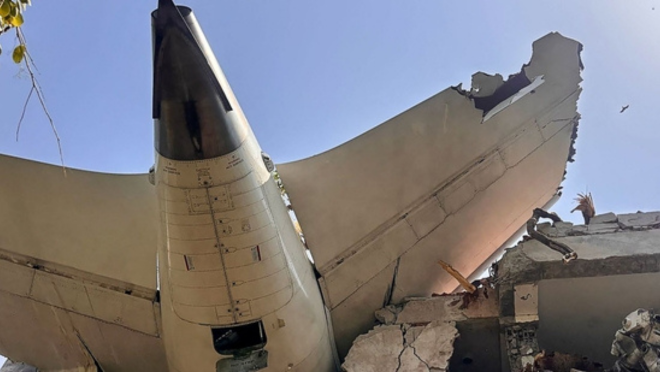Boeing under scrutiny again after Air India crash: a history of ignored warnings
Boeing under scrutiny again after Air India crash: a history of ignored warnings

On 12 June 2025, a Boeing 787 Dreamliner Air India Flight AI 171 crashed in Ahmedabad, carrying 242 passengers and crew members. The crash resulted in the fatality of more than 240 people, including people on ground as it hit a residential area, reports Reuters. Only one passenger is reported to survive the crash.
This tragic incident came just over a year after Sam Salehpour, a senior engineer in Boeing’s quality assurance department, testified before the US Senate pleading for the grounding of 1,000 Boeing 787 and 777 Dreamliners.
He cited negligence of safety procedures and manufacturing malpractices. Although the Senate committee heard his full testimony and lawsuits were filed, the grounding of the planes was ultimately not implemented.
Boeing’s negligence in its manufacturing process had already been a major topic in western media in the years prior. The first major controversy surfaced after a fatal crash near Jakarta, Indonesia, on 29 October 2018. A Boeing 737 MAX 8 aircraft crashed into the Java Sea shortly after taking off from Jakarta, killing all 189 people on board.
The investigation revealed that a new automated system called the Maneuvering Characteristics Augmentation System (MCAS) had pushed the nose of the plane down repeatedly based on faulty sensor data. Pilots had not been trained or even informed about this system, triggering a massive backlash against Boeing and the FAA (Federal Aviation Administration).
However, this was not an isolated incident. A pattern emerged as Ethiopian Airlines Flight 302 in March 2019, Ukraine International Airlines Flight 752 on 8 January 020, China Eastern Airlines Flight 5735 on 21 March 2022, the Coulson Aviation Boeing 737 crash (firefighting tanker) on 6 February 2023, Alaska Airlines Flight 1282 on 5 January 2024, Southwest Airlines Flight 746 on 25 May 2024, and Korean Air Flight 189 on 22 June 2024 all suffered due to alleged irregularities during the production process and faulty sensors.
These incidents culminated in the deaths of hundreds, forcing Boeing to ground 400 planes. Aviation authorities in the EU, Canada, China and eventually the US FAA discontinued operations of the 737 MAX.
This crisis was not limited to a single Boeing model. In late 2023, more whistleblowers from inside Boeing began coming forward. Chief among them was Sam Salehpour. He testified that irregularities had been identified yet ignored by Boeing’s internal inspection team.
Salehpour claimed that the push to speed up production had led to serious problems with the aircraft, including small gaps between fuselage sections. He added, “manufacturing errors left them (787 and 777) structurally unsound.”
Salehpour also explained that this pattern of irregularity had been ongoing since 2013. Gaps between major joints and hinges had never been properly stress tested, and repeated concerns raised by him and the QA team had been ignored.
In the senate hearing Salehpour discussed these alarming matters concerning Boeing’s manufacturing process. “In a rush to address production bottlenecks, Boeing hid manufacturing gaps by pushing pieces together with excessive force to close the existing gaps. Not addressing these gaps will eventually lead to premature fatigue failure,” he said.
“I found gaps that were not properly addressed 98.7 percent of the time. I want to repeat that — 98.7 percent of the time, the gaps were not properly addressed,” said Sam.
Boeing used an unmeasured amount of force to fix the misalignment, with Sam even claiming he saw engineers jumping on the pieces to force alignment, which he alarmingly nicknamed “the Tarzan alignment effect.”
The 737 scandal had earlier led Boeing to settle out of court and pay a total of $2.5 billion to the FAA for misleading the 737 MAX certification process. Following Salehpour’s testimony, the FAA launched a formal investigation into potential structural defects and assembly shortcuts on Boeing 787 and 777 jets.
The agency ordered Boeing to submit a corrective plan addressing systemic quality-control issues within 90 days. However, Boeing was not held criminally liable for the alleged manufacturing malpractices. After an internal audit and reinspection of 787 and 777 flights, they were cleared for delivery to customers.
With a history of malpractice and disregard for safety, it is disappointing that Boeing was left to inspect the 787s and 777s without external oversight. The claims made by Sam Salehpour were dismissed, and his recommendation to ground and recheck 1,000 planes was not acted upon.
This brings the timeline back to 12 June 2025. Boeing issued a formal statement but did not comment on the aircraft’s condition or safety precautions. While the incident is under investigation and conclusions cannot yet be drawn, it is clearly a matter of life and death. Greater insight must be revealed about the 787’s history. The accusations raised by internal engineers should not be taken lightly after such a horrific tragedy.


